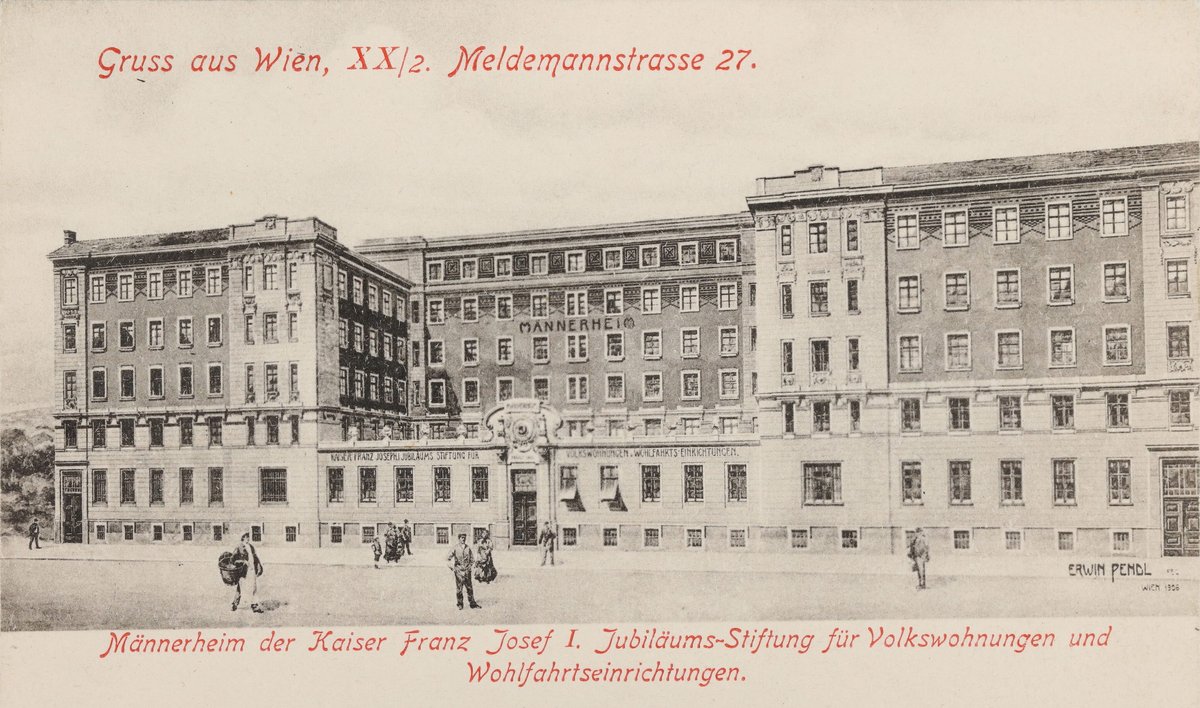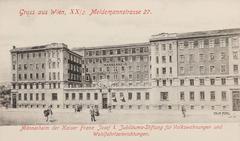
Meldemannstraße Dormitory Visitor Guide: Hours, Tickets, and Vienna Historical Sites
Date: 14/06/2025
Introduction
The Meldemannstraße Dormitory in Vienna’s Brigittenau district stands as a landmark of early 20th-century social reform and municipal housing innovation. Built between 1905 and 1906, it was among the first large-scale efforts to provide dignified accommodation for the city’s working-class men during a period of rapid urban growth and industrialization. Although today it operates as a senior residence and is not open to the public, its architectural legacy and social history—most notably as the former residence of Adolf Hitler—make it a point of interest for visitors exploring Vienna’s multifaceted past (Wien Geschichte Wiki; Der Standard).
This guide provides a detailed overview of the dormitory’s origins, architectural features, social impact, and practical advice for visitors—plus recommendations for related historical sites in Vienna.
Table of Contents
- Introduction
- Origins and Construction
- Architectural Features and Facilities
- Social and Historical Context
- Adolf Hitler’s Residency (1910–1913)
- Later History and Current Status
- Visiting Meldemannstraße Dormitory: Information & Practicalities
- Cultural Significance and Social Impact
- Responsible Visiting & Etiquette
- Frequently Asked Questions (FAQ)
- Resources and Further Reading
- Summary & Next Steps
Origins and Construction
At the turn of the 20th century, Vienna’s population boomed, intensifying the city’s housing crisis—especially for single, working-class men known as “Bettgeher,” who often rented beds by the hour in overcrowded apartments. In response, the Meldemannstraße Dormitory was commissioned by the Gemeinnützige Baugesellschaft für Männerwohnheime (Non-Profit Building Association for Men’s Dormitories) and opened in 1905 (Wien Geschichte Wiki; Austria-Forum).
Architects Leopold Ramsauer and Otto Richter drew inspiration from London’s Rowton Houses, designing the facility to offer both privacy and communal support. The building housed up to 544 men in individual cabins, each measuring roughly 1.4 by 2.2 meters and equipped with a bed, table, clothes hanger, mirror, and lockable door (Wikipedia; Rote Spuren).
Architectural Features and Facilities
The Meldemannstraße Dormitory set new standards for working-class accommodation in Vienna. Key features included:
- Individual sleeping cabins with electric lighting (centrally switched off at night).
- Modern communal amenities: dining hall, reading rooms, library, washrooms, showers, medical room, and laundry.
- Social spaces: smoking/non-smoking lounges and recreation rooms.
- Self-catering kitchens with gas stoves and utensils for residents.
- Workshops and storage for bicycles and luggage in the basement.
The weekly rent was 2.50 crowns, considered affordable for laborers at the time (more.io.vn). The press lauded the dormitory as a “paradise on earth” and a “wonder of elegance and inexpensiveness.”
Social and Historical Context
The dormitory was a pioneering example of social housing, predating Vienna’s celebrated “Red Vienna” era. It represented a progressive response to acute urban poverty and public health concerns, aiming to provide not only shelter but also dignity and social integration for marginalized men (Wien Museum).
Adolf Hitler’s Residency (1910–1913)
The Meldemannstraße Dormitory is perhaps most famous for having housed Adolf Hitler during his formative years in Vienna. From 1910 to 1913, Hitler lived here while attempting to launch his career as an artist. His experiences of poverty, social exclusion, and exposure to Vienna’s political currents in this period are widely regarded as formative in his later life (BBC History; United States Holocaust Memorial Museum). This association has made the site a subject of historical research, literature, and educational walking tours.
Later History and Current Status
After World War I, the building continued to serve Vienna’s poor and homeless, and was briefly a military and civilian hospital. In 1922, it was acquired by the city and later became a care home. After WWII, it housed displaced persons and continued to function as a shelter for men in need (Rote Spuren).
The dormitory closed in 2003. Since 2009, it has been reconfigured as “Seniorenschlössl Brigittenau,” a senior residence, while retaining its historic façade (Der Standard; Stadt Wien).
Visiting Meldemannstraße Dormitory: Information & Practicalities
Viewing Hours and Tickets
- Interior Access: The Meldemannstraße Dormitory is not open to the public for interior visits or tours.
- Tickets: No tickets are required; there is no entry fee.
- Exterior Viewing: The façade and exterior are visible from the street at any time. Please be respectful of residents.
Accessibility and Getting There
- Address: Meldemannstraße 27, 1200 Vienna, Austria (main entrance on Winarskystraße).
- Public Transport: U-Bahn line U6 (Dresdner Straße station), tram lines 2 and 31.
- By Car: Limited street parking; public transport is recommended.
- Neighborhood: Brigittenau is a working-class district with level, wheelchair-accessible sidewalks.
Guided Tours and Alternatives
- No official tours are available for the dormitory itself.
- Vienna walking tours of social and political history may include the site’s exterior and context (Vienna Tourist Information; City-Walks).
- Nearby:
- Karl-Marx-Hof: An iconic “Red Vienna” social housing complex.
- Augarten Park: Historic park and gardens.
- Vienna Prater: Amusement park and green space.
- Kunst Haus Wien: Museum of Hundertwasser.
- St. Stephen’s Cathedral: Vienna’s iconic Gothic cathedral.
Facilities and Amenities
- No public restrooms on-site.
- Shops and cafes nearby; most shops close on Sundays.
- Public WiFi available in some transport hubs (Wien Info).
- Accommodation: Numerous options in Brigittenau and throughout Vienna (Booking.com).
Visitor Tips
- Best visited during daylight for safety and best visibility.
- Photography: Permitted from the street; use alt text like “Meldemannstraße Dormitory Vienna exterior” for accessibility and SEO.
- Etiquette: Be respectful—this is an active residence for seniors. Do not disturb residents or photograph private areas.
Cultural Significance and Social Impact
The Meldemannstraße Dormitory symbolizes Vienna’s early commitment to public welfare and urban reform. Its innovative model influenced the “Red Vienna” housing movement and inspired similar initiatives in Europe. The building’s layered history, including its infamous resident, invites reflection on the intersections of poverty, urban planning, and political history (Austria-Forum).
Responsible Visiting & Etiquette
Given the dormitory’s sensitive history and current function as a retirement home, visitors should approach with respect. Focus on its broader social welfare significance and avoid sensationalizing its connection to Hitler. Maintain privacy for current residents and the surrounding community.
Frequently Asked Questions (FAQ)
Q: Can I enter the Meldemannstraße Dormitory?
A: No, interior access is restricted as it is now a private senior residence.
Q: Are guided tours available?
A: No official tours of the dormitory, but some Vienna history walks include the exterior.
Q: What are the visiting hours?
A: There are no set hours; exterior can be viewed at any time.
Q: Are there tickets or an entrance fee?
A: No, visiting the exterior is free.
Q: Is the area accessible for visitors with disabilities?
A: Yes, sidewalks and nearby public transport are accessible.
Resources and Further Reading
For more on Meldemannstraße Dormitory and Vienna’s social history:
- Wien Geschichte Wiki
- Der Standard
- Wien Museum
- United States Holocaust Memorial Museum
- BBC History
- Wikipedia
- Rote Spuren
- Austria-Forum
- Vienna Tourist Information
- City-Walks
Summary & Next Steps
The Meldemannstraße Dormitory is a compelling testament to Vienna’s evolving social landscape—once a haven for working men, later a witness to the city’s turbulent political currents, and today a symbol of enduring community care. While interior visits are not possible, the building’s façade and history remain accessible to all. For a deeper understanding, combine your visit with guided walks of Vienna’s social housing heritage and use digital resources for research and context.
To enhance your exploration, download the Audiala app for curated walking tours, interactive maps, and up-to-date information on Vienna’s historical sites. Share your experiences on social media using #MeldemannstraßeDormitory, and connect with others interested in Vienna’s layered past.






















































































































































